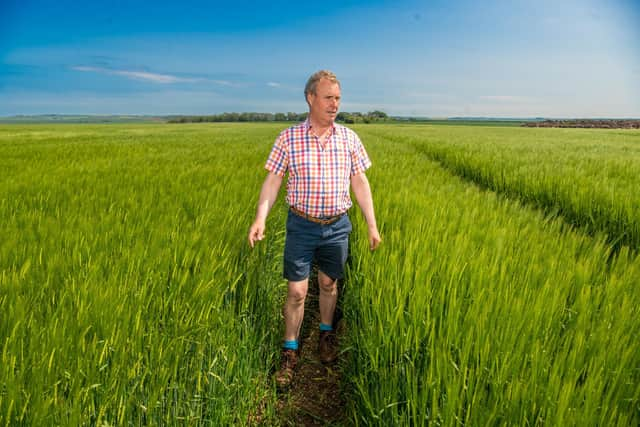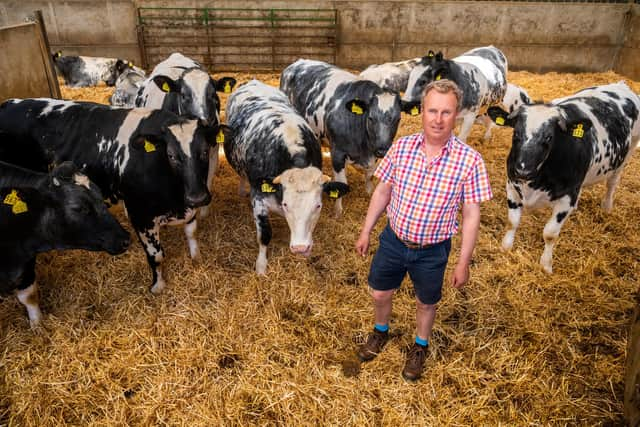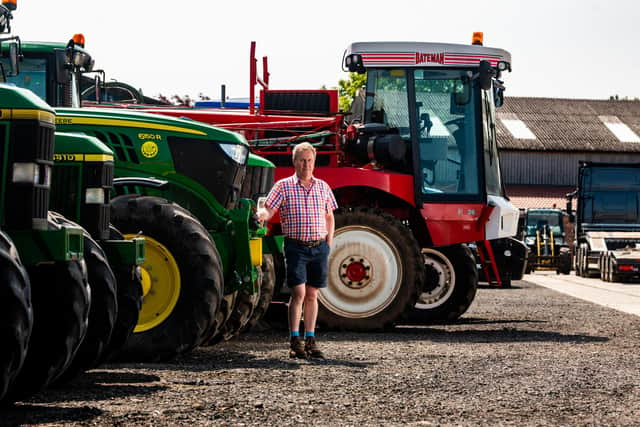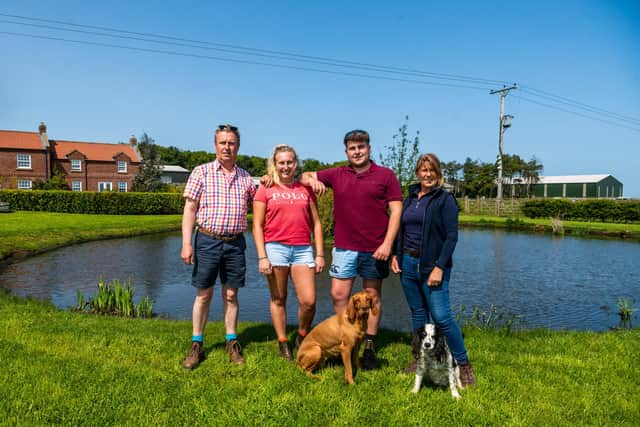Farm of the Week: Tractor dealers who sold machinery to fund purchase of their own land
Seven years ago the couple moved to Danebury Manor Farm where they run a mixed farm growing cereal crops, finishing cattle and overwintered store lambs and let a bed and breakfast pigs enterprise across the 450 acres, while also having other land elsewhere that takes them to around 600 acres in all.
Many farming people in the area will know Martin for his tractor and farm machinery dealership GM Stephenson. He recently completed a two-year stint as chairman of the East Coast branch of the National Farmers Union and has been farming for many years, having taken on parcels of land previously including 40 acres that his father tenanted in Seamer where Martin grew up.
Advertisement
Hide AdAdvertisement
Hide AdMartin says it is very much a team effort with himself and Deb, a number of good people and their children Harriet and George also involved.


“I’d always been a bit of a wheeler dealer from being very young when my father used to work for Boulton & Cooper at the old Seamer Mart. I’d buy 3-furrow ploughs and the odd Fergie in those days and started my machinery business when I was 18. We’ve bought bits and pieces of land too, as Deb and I went along, thinking that one day we might be fortunate to buy a complete farm.
“We bought 40-acre Southfield Farm in Flixton in 2003 and developed that into various other businesses, we had the acreage that my father had, and took on other land too at Kilham.
“Across our whole acreage we now have around 400 acres of arable land, on what is largely typical Wolds land of chalk with some flint. We also have 150 acres of grass, split between grazing land and silage grasses.
Advertisement
Hide AdAdvertisement
Hide Ad“We grow 200 acres of wheat, 100 acres of winter barley, and 100 acres of peas and spring barley as a combined crop with the seed mixed in the drill. The peas are a great protein for the cattle.


“We came out of oilseed rape three years ago, the point being that we want to produce what we can feed, and we feed every grain we produce. We also get the straw from the peas and barley mix. Our wheat yield is generally around 4 tonnes per acre.
“It has been a cold, wet spring. We have only just drilled our spring barley and peas in the past three to four weeks, which is probably two weeks behind where I wanted to be, but the soil temperature needed to be warmer for the peas. There’s no point putting them in when it’s not.
Martin’s crop establishment is now focused on min-till.
“We are moving away from ploughing. We started three years ago and are now doing what I would call top cultivation to incorporate the manure with minimum tillage.
Advertisement
Hide AdAdvertisement
Hide Ad

“We are learning how best to deal with the soil. Some Wold farmland is quite abrasive and to plough it and work it all down can be quite expensive from a fuel and wearing metal point of view. I really don’t see the need to plough it all, especially if you can work it from the top and see good results. I believe our soil is getting easier to work because we are incorporating the organic matter back into the top three or four inches.
“A big part of what we do is having livestock and that livestock produces manure. We are just starting to see the results of putting all that organic matter on the land after six years of doing so, and it does more than reduce your fertiliser bill. It adds warmth to the soil and it helps hold moisture. It’s dry and it puts the land into better condition.
Cattle and sheep are bought in and Martin tells of how his livestock system works.
“We have a full-time livestock manager Chris Moore. We buy a mixture of bullocks and heifers at around 350 kilos, supplied mostly by a local livestock agent, but with some also bought privately and from local marts. We finish them at 650-700 kilos liveweight. We will finish between 700-800 cattle during the year with somewhere between 400-500 on at any one time.
Advertisement
Hide AdAdvertisement
Hide Ad

“Our pens hold 30-40 cattle and we buy in batches. When they arrive we feed them silage to settle them down for the first couple of months from our 70 acres of silage grasses from which we take three cuts. They then move on to a straw and cereal mix. We mill our own grain on site and feed 50-50 wheat and barley.
“We start buying store lambs in September and continue until November and get to around 650. We sow 50-60 acres of stubble turnips after the winter barley is harvested in July. The store lambs also tidy up the grazing behind the cattle.
“Half the finished lambs go through Malton Mart with the other half to Worsley butchers at Spennymoor. We start selling them in March and sell 100 per week for the next six or seven weeks.
The pig enterprise is a joint venture between the Stephensons and former employee Steve Winkfield, that works well for both parties.
Advertisement
Hide AdAdvertisement
Hide Ad“We have let the pig unit to Steve on a Farm Business Tenancy. We provide the straw, water and buildings and he provides the labour and machinery. We get the manure back. We share the income from the bed and breakfast pig enterprise. Pigs are Steve’s passion.
Making things work and having a great team around him have always been the way in which Martin has gone about his business, which still includes storage units, storage containers and workshops and industrial units let.
He and Deb have now moved the farm machinery business up to Danebury Manor.
“It made sense,” says Martin. “Now if I’m needed on the farm or the machinery side I’m on hand within a few minutes, but everyone here is capable of turning their hand to everything.
Advertisement
Hide AdAdvertisement
Hide Ad“Deb looks after all the paperwork for the farm and much more, we have our great office manager Debbie Scaife, and livestock manager Chris Moore, as well as others on the team. Harriet has just got back from having worked and toured Australia, and George returned from doing the same in New Zealand three weeks ago and is now really involved with the farm machinery business.
“Harriet is well capable of doing anything on farm, in fact of all four of myself, Deb, Harriet and George I’m the only one without an HGV licence.
Earlier this week Martin hosted an NFU Farm Walk. Whilst he was delighted to do so he says that encouragement of the general public to understand more about where food comes from is something he would like to explore more greatly in the future.
“I don’t think we, as farmers, engage with the public enough. Some have absolutely no idea where their food comes from. I would like to get more involved locally with schools coming on farm visits and if any would like to come, please get in touch.